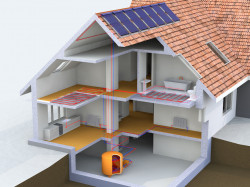Sim4Blocks Webinar: Enhanced energy efficient control systems
This is the second instalment from a series of webinars presented by Sim4Blocks partners on the developing progress of the project. Marcus Brennenstuhl, from the Stuttgart Technology University of Applied Sciences (HFT Stuttgart), Germany, specialises in sustainable energy technology and led the second Sim4Blocks webinar instalment on “Thermal building demand and energy conversion models. Methodology and Optimisation”. Marcus presented HFT Stuttgart’s designs for a highly detailed computer-based building model to more accurately simulate the frameworks for renewable components and better match fluctuating supply and demand. The electronic building model is to guarantee more accurate results for energy management solutions. HFT’s simulated building model follows the nodal method, common for building simulations, whereby the building is divided into zones known as nodes (e.g. the window, a wall, under floor heating) and the thermal energy transfer equations between each zone can be separately solved. By looking at each zone as individual internal connectors for blocks in a building, each node can be easily connected by uniform state variables for optimal energy management. HFT went on to shed light on future 3D models they wish to use for larger groups of buildings for more dynamic simulations. Improved energy efficiency The presentation looked at five energy conversion system models, including thermal stratification storage tanks. A stratified storage tank – which works via the natural propensity for warm water to settle on top of cold water – has a higher flexibility potential for demand response, compared to a fully mixed storage tank. Stratified storage therefore, provides better COP (co-efficiency of performance) and lower running costs. This is also the purpose for selecting lower loading temperatures for space heating (test fixed at 35˚C) and domestic hot water (test fixed at 45˚C). Computer based optimisation The simulation model runs on a cloud based virtual machine, where the monitoring data from the real buildings is stored in a MySQL database. Based on weather predictions, heuristic optimisations are carried out which lead to the creation of schedules for the ongoing building system operation 24 hours in advance. A standard optimisation goal would be minimising electricity prices for the user. Innovation Whilst Marcus made it clear that their thermal building demand model is fairly well researched and discussed in similar projects already, the presentation promised signs of real innovation in HFT’s investigations. The utilisation of enhanced algorithms, the incorporation of signals from the pumps to closely monitor their behaviour, and the connection of simulations from the energy and electrical networks to the building model for improved results are just a few of the new advances HFT’s research is planning to explore. The webinar concluded with a rewarding round-table Q&A discussion. You can find out more about Sim4Blocks project by visiting their website: http://www.sim4blocks.eu/(opens in new window)
Countries
Belgium, Switzerland, Germany, Spain, France, United Kingdom



